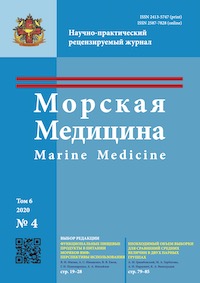Abstract
The purpose of the study is to analyze the primary incidence of conscript military personnel of the Navy and Ground Forces over the last 10 years from 2010–2019.
Methodology. We conducted a selective statistical analysis of medical reports on the health status of personnel and the activities of the medical service in the form of 3/MED of military units, in which served about 80% of the total number of conscript military personnel of the Navy and Russian Ground Forces. The primary incidence of conscript military personnel was correlated with the chapters of the International Classification of Diseases, 10 th revision (ICD-10).
Results and their discussion. The average annual incidence rate of conscript military personnel for the Navy amounted to 1143,4–59,1‰, of the Ground Forces was higher at the level of trends — 1345,9–86,1‰. The dynamics of the primary incidence of conscript military personnel of the Navy showed a decrease in data, the Ground Forces — resembled an inverted U-curve with maximum rates in 2013–2014. The leading chapters of diseases of the primary incidence of the Russian Navy and the Army were respiratory diseases (X chapter), skin and subcutaneous tissue diseases (XII chapter), some infectious and parasitic diseases (chapter I), digestive diseases (XI chapter) and bone disease -muscular system and connective tissue (XIII chapter). The total contribution of these classes to the structure was 83,9 and 84,5%, respectively. Indicators of primary morbidity of acute respiratory infections of the upper respiratory tract (J00–J06), infections of the skin and subcutaneous tissue (L00–L08), and other acute lower respiratory infections were of a different significance for the conscripts of the Russian Navy and the Ground Forces of rank 1–6 respiratory tract (J20–J22), flu and pneumonia (J10–J18), diseases of the esophagus, stomach and duodenum (K20–K31) and viral infections characterized by lesions of the skin and mucous membranes (B00–B09). The distinctive features of the primary morbidity of military personnel of the Navy and Ground Forces by disease classes and leading nosologies are revealed. The total contribution of the listed nosologies (groups in chapters) to the structure was 71,3 and 73,2%, respectively.







